Analysis of Potato Growth, Water Consumption Characteristics and Irrigation Strategies in the Agro-Pastoral Ecotone of Northwest China
Abstract
1. Introduction
2. Materials and Methods
2.1. Study Area
2.2. Experimental Design
2.3. Measured Indicators
2.3.1. Soil Data Collection
2.3.2. Meteorological Data Collection
2.3.3. Growth Period
2.3.4. Irrigation Quota
2.4. Research Methods
2.4.1. Overview of the DSSAT Model
2.4.2. Constructed Model and Calculated Equation
2.4.3. Sensitivity Analysis
2.4.4. Uncertainty Analysis Method
2.4.5. Calibration and Validation
2.5. Evaluated Indictor of Potato Irrigation Efficiency
3. Results
3.1. Sensitivity Analysis and Uncertainty Analysis
3.1.1. Uncertainty Analysis
3.1.2. Uncertainty Analysis
3.2. Model Calibration and Validation
3.2.1. Model Calibration
3.2.2. Model Validation
3.3. Dynamics of Soil Moisture, Leaf Area Index, and Potato Yield
3.4. Water Consumption Patterns of Potatoes
3.5. Water Balance Estimation and Water Use Efficiency Evaluation for Potatoes
3.5.1. Water Balance Estimation for Potatoes
3.5.2. Water Use Efficiency Evaluation of Potatoes
3.6. Optimization of Potato Irrigation Strategies Under Different Hydrological Conditions
3.6.1. Classification of Hydrological Years
3.6.2. Analysis of Precipitation Patterns During Potato Growing Season
3.6.3. Evaluating Potato Irrigation Management Approaches Under Different Hydrological Conditions
3.6.4. Optimal Irrigation Water Volume in Different Hydrological Years
4. Discussion
5. Conclusions
- (1)
- This study found that simulated values of the soil water moisture, leaf area index, and yield, with Absolute Relative Error (ARE) of 4.18–5.27%, Normalized Root Mean Square Error (nRMSE) of 5.64–8.65%, and R of 0.86–0.921, represented acceptable accuracy. The DSSAT model can be applied to the research area.
- (2)
- Total water consumption of potatoes ranged from 375.2 mm to 414.2 mm, with the tuber formation to bulking stages accounting for 50–52% of total water consumption and a water consumption intensity of 2.62–2.81 mm/d. The WUE and IWUE were 162.17–166.20 kg/hm2·mm and 86.1–108.1 kg/hm2·mm, respectively.
- (3)
- Targeting maximum potato yield, the recommended irrigation amounts were 180 mm for normal years and 240 mm for dry years. To prioritize groundwater use efficiency, irrigation amounts are 162 mm and 192 mm for normal and dry years, respectively. These findings offer a theoretical foundation for implementing water-saving and high-yield irrigation management practices for potato cultivation in the region.
Author Contributions
Funding
Data Availability Statement
Acknowledgments
Conflicts of Interest
References
- Zhang, C.; Su, J.; Du, Z. Ecological problems and countermeasures of the agro-pastoral ecotone at the northern foot of Yinshan Mountain in Inner Mongolia. Ecol. Agric. Res. 1999, 4, 30. [Google Scholar]
- Qing, S.; An, W. Potato-Crop with Advantage in Hilly Areas the Northern Foot of Yin Mountain. China J. Agric. Resour. Reg. Plan. 2004, 25, 1–4. [Google Scholar]
- Jin, X. Study on the Effects of Changes in Irrigation Patterns on Groundwater in Farming-Pastoral Zones in Semi-Arid Areas. Ph.D. Thesis, China Institute of Water Resources and Hydropower Research, Beijing, China, 2019. [Google Scholar]
- Wang, H.; Cheng, M.; Zhang, S.; Fan, J.; Feng, H.; Zhang, F.; Wang, X.; Sun, L.; Xiang, Y. Optimization of irrigation amount and fertilization rate of drip-fertigated potato based on Analytic Hierarchy Process and Fuzzy Comprehensive Evaluation methods. Agric. Water Manag. 2021, 256, 107130. [Google Scholar] [CrossRef]
- Zhang, Y.; Wang, F.; Nie, W.; Feng, S. Effects of Film Mulching on Thermal Conditions and Potato Growth under Drip Irrigation. Trans. Chin. Soc. Agric. Mach. 2020, 51, 252–261. [Google Scholar]
- Li, H.; Chai, S.; Chang, L.; Cheng, H.; Han, F.; Chai, Y. Effects of earthing up on yield and water use efficiency of potato under straw strip mulching planting pattern. Trans. Chin. Soc. Agric. Eng. 2019, 35, 107–115. [Google Scholar]
- Wang, H.; Cheng, M.; Liao, Z.; Guo, J.; Zhang, F.; Fan, J.; Feng, H.; Yang, Q.; Wu, L.; Wang, X. Performance evaluation of AquaCrop and DSSAT-SUBSTOR-Potato models in simulating potato growth, yield, and water productivity under various drip fertigation regimes. Agric. Water Manag. 2023, 276, 108076. [Google Scholar] [CrossRef]
- Cao, Z.; Liu, Y.; Zhang, X.; Shen, B.; Qin, S.; Liu, Z.; Wang, L.; Li, Z.; Zhang, J. Effects of deficit irrigation on growth, yield, and water use of potato plants. Trans. Chin. Soc. Agric. Eng. 2019, 35, 114–123. [Google Scholar]
- Tang, J.; Xiao, D.; Bai, H. Yield and water use efficiency of potato at different irrigation levels in agro-pastoral ecotone under future climate change. Trans. Chin. Soc. Agric. Eng. 2020, 36, 103–112. [Google Scholar]
- Rolbiecki, R.; Rolbiecki, S.; Figas, A.; Jagosz, B.; Stachowski, P.; Sadan, H.A.; Prus, P.; Pal-Fam, F. Requirements and Effects of Surface Drip Irrigation of Mid-Early Potato Cultivar Courage on a Very Light Soil in Central Poland. Agronomy 2020, 11, 33. [Google Scholar] [CrossRef]
- Molaei, B.; Gheysari, M.; Mostafazadeh-Fard, B.; Landi, E.; Majidi, M.M. Evaluation of yield and yield characteristics of two potato varieties under sprinkler and trickle irrigation systems. J. Water Soil Sci. 2015, 19, 241–251. [Google Scholar] [CrossRef]
- Camargo, D.; Montoya, F.; Córcoles, J.; Ortega, J. Modeling the impacts of irrigation treatments on potato growth and development. Agric. Water Manag. 2015, 150, 119–128. [Google Scholar] [CrossRef]
- Montoya, F.; Camargo, D.; Córcoles, J.I.; Domínguez, A.; Ortega, J.F. Analysis of deficit irrigation strategies by using SUBSTOR-Potato model in a semi-arid area. J. Agric. Sci. 2020, 157, 578–591. [Google Scholar] [CrossRef]
- Li, S.; An, P.; Pan, Z.; Wang, F.; Li, X.; Liu, Y. Farmers’ initiative on adaptation to climate change in the Northern Agro-pastoral Ecotone. Int. J. Disaster Risk Reduct. 2015, 12278–12284. [Google Scholar] [CrossRef]
- Miao, X.; Wang, G.; Li, R.; Xu, B.; Zheng, H.; Tian, D.; Wang, J.; Ren, J.; Li, Z.; Zhou, J. Study on Modeling and Evaluating Alfalfa Yield and Optimal Water Use Efficiency in the Agro-Pastoral Ecotone of Northern China. Plants 2024, 13, 229. [Google Scholar] [CrossRef]
- Gao, S.; He, P.; Gong, X.; Li, H.; Liu, Y.; Wang, Q.; Wang, X.; He, A.; Fu, Y. Sensitivity and uncertainty analysis of wheat cultivar parameters of the DSSAT model under different water and N treatments. Sci. Rep. 2025, 15, 10441. [Google Scholar] [CrossRef]
- Zhu, B.; Chen, S.; Xu, Z. The estimation of maize grain protein content and yield by assimilating LAI and LNA, retrieved from canopy remote sensing data, into the DSSAT model. Remote Sens. 2023, 15, 2576. [Google Scholar] [CrossRef]
- Lin, Z.; Li, Y.; Hoogenboom, G.; Gao, Y.; Wu, B.; Wu, L.; Wu, L.; Zhou, H.; Yan, B.; Lu, P.; et al. DSSAT modeling of oilseed flax (Linum usitatissimum L.): Sensitivity analysis of yield to weather variability and nitrogen application. Field Crop. Res. 2025, 328, 109930. [Google Scholar] [CrossRef]
- Foumani, M.P.; Yin, X.; Fu, J.S.; Yang, C.E.; Adotey, R. Impact of future climate from different general circulation models on cotton yield predictions in north Cotton Belt through crop simulation with DSSAT. Field Crops Res. 2025, 322, 109719. [Google Scholar] [CrossRef]
- Wang, X.; Xin, L.; Du, J.; Li, M. Simulation of cotton growth and yield under film drip irrigation condition based on DSSAT Model in southern Xinjiang. Agric. Water Manag. 2022, 53, 314–321. [Google Scholar]
- Jiang, Y.; Zhang, L.; Zhang, B.; He, C.; Jin, X.; Bai, X. Modeling irrigation management for water conservation by DSSAT-maize model in arid northwestern China. Agric. Water Manag. 2016, 177, 37–45. [Google Scholar] [CrossRef]
- Wang, P. Research of Optimizing Deficit Irrigation for Sugarcane in Guangxi Province Using the DSSAT Model Based on Genetic Algorithm. Master’s Thesis, Hebei University of Engineering, Handan, China, 2022. [Google Scholar]
- Singels, A.; Bezuidenhout, C. A new method of simulating dry matter partitioning in the Canegro sugarcane model. Field Crops Res. 2002, 78, 151–164. [Google Scholar] [CrossRef]
- Xu, R.; He, Y.; Zhao, X.; Luo, S.; Yang, J.; Yu, J.; Zhu, Y.; Zhao, C.; Li, Z. Analysis on Potato Potential Yield and Its Influencing Factors in Northeast China from 1961 to 2017 Based on the DSSAT Model. Chin. J. Agric. Resour. Reg. Plan. 2021, 42, 102–114. [Google Scholar]
- Zhang, M. Remote Sensing for Maize Nitrogen Nutrition Diagnosis Based on Field Experiments and the DSSAT Model. Master’s Thesis, Jilin University, Changchun, China, 2023. [Google Scholar]
- Wu, C.; Anlauf, R.; Ma, Y. Application of the DSSAT model to simulate wheat growth in eastern China. J. Agric. Sci. 2013, 5, 198–208. [Google Scholar] [CrossRef]
- Yan, W.; Jiang, W.; Han, X.; Hua, W.; Yang, J.; Luo, P. Simulating and Predicting Crop Yield and Soil Fertility under Climate Change with Fertilizer Management in Northeast China Based on the Decision Support System for Agrotechnology Transfer Model. Sustainability 2020, 12, 2194. [Google Scholar] [CrossRef]
- Falge, E.; Baldocchi, D.; Olson, R.; Anthoni, P.; Aubinet, M.; Bernhofer, C.; Burba, G.; Ceulemans, R.; Clement, R.; Dolman, H.; et al. Gap filling strategies for defensible annual sums of net ecosystem exchange. Agric. For. Meteorol. 2001, 107, 43–69. [Google Scholar] [CrossRef]
- Wang, G.; Shi, H.; Li, X.; Zheng, Q.; Guo, J.; Wang, W. Analysis of water and salt transportation and balance during cultivated land, waste land and lake system in Hetao Irrigation Area. J. Hydraul. Eng. 2019, 50, 1518–1528. [Google Scholar]
- Blum, A. Effective use of water (EUW) and not water-use efficiency (WUE) is the target of crop yield improvement under drought stress. Field Crops Res. 2009, 112, 119–123. [Google Scholar] [CrossRef]
- Attia, A.; Rajan, N.; Xue, Q. Application of DSSAT-CERES-Wheat model to simulate winter wheat response to irrigation management in the Texas High Plains. Agric. Water Manag. 2016, 165, 50–60. [Google Scholar] [CrossRef]
- Zhang, F.; Gao, Y.; Jiao, W.; Hu, W. Effect of water and fertilizer supply on growth, water and nutrient use efficiencies of potato in sandy soil of Yulin area. Trans. Chin. Soc. Agric. Mach. 2017, 48, 1–9. [Google Scholar]
- Song, N.; Wang, F.; Yang, C.; Yang, K. Coupling effects of water and nitrogen on yield, quality and water use of potato with drip irrigation under plastic film mulch. Trans. Chin. Soc. Agric. Eng. 2013, 29, 98–105. [Google Scholar]

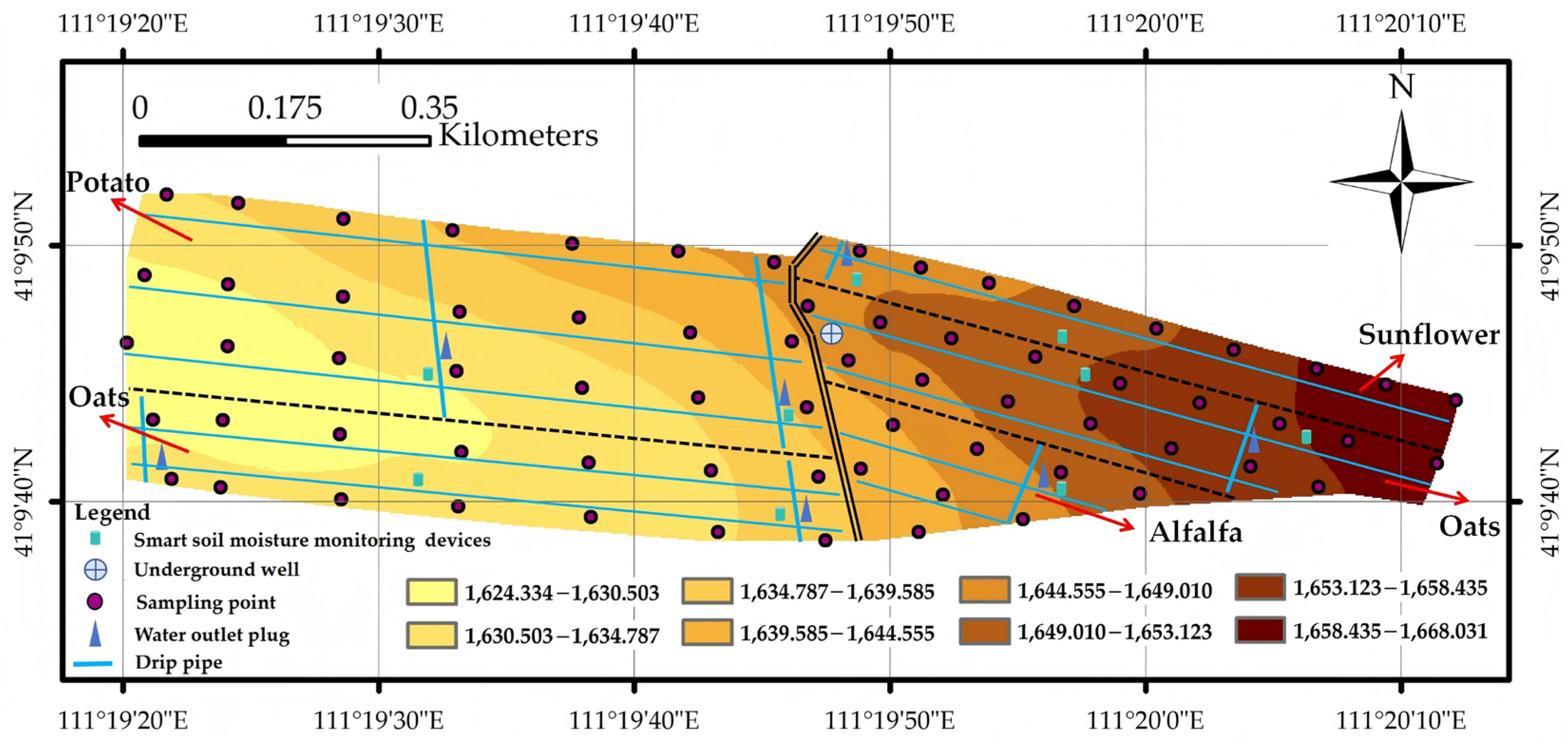
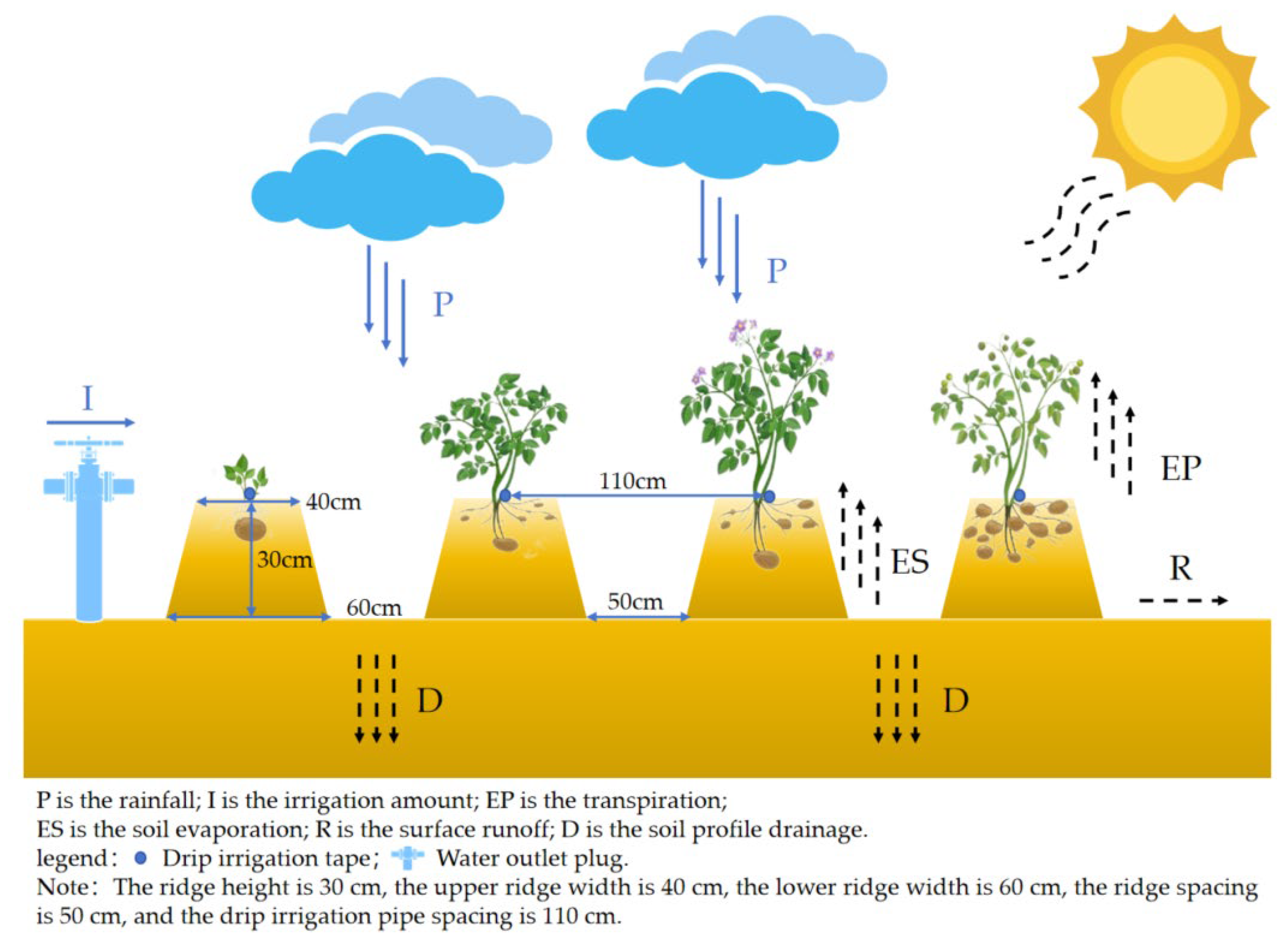
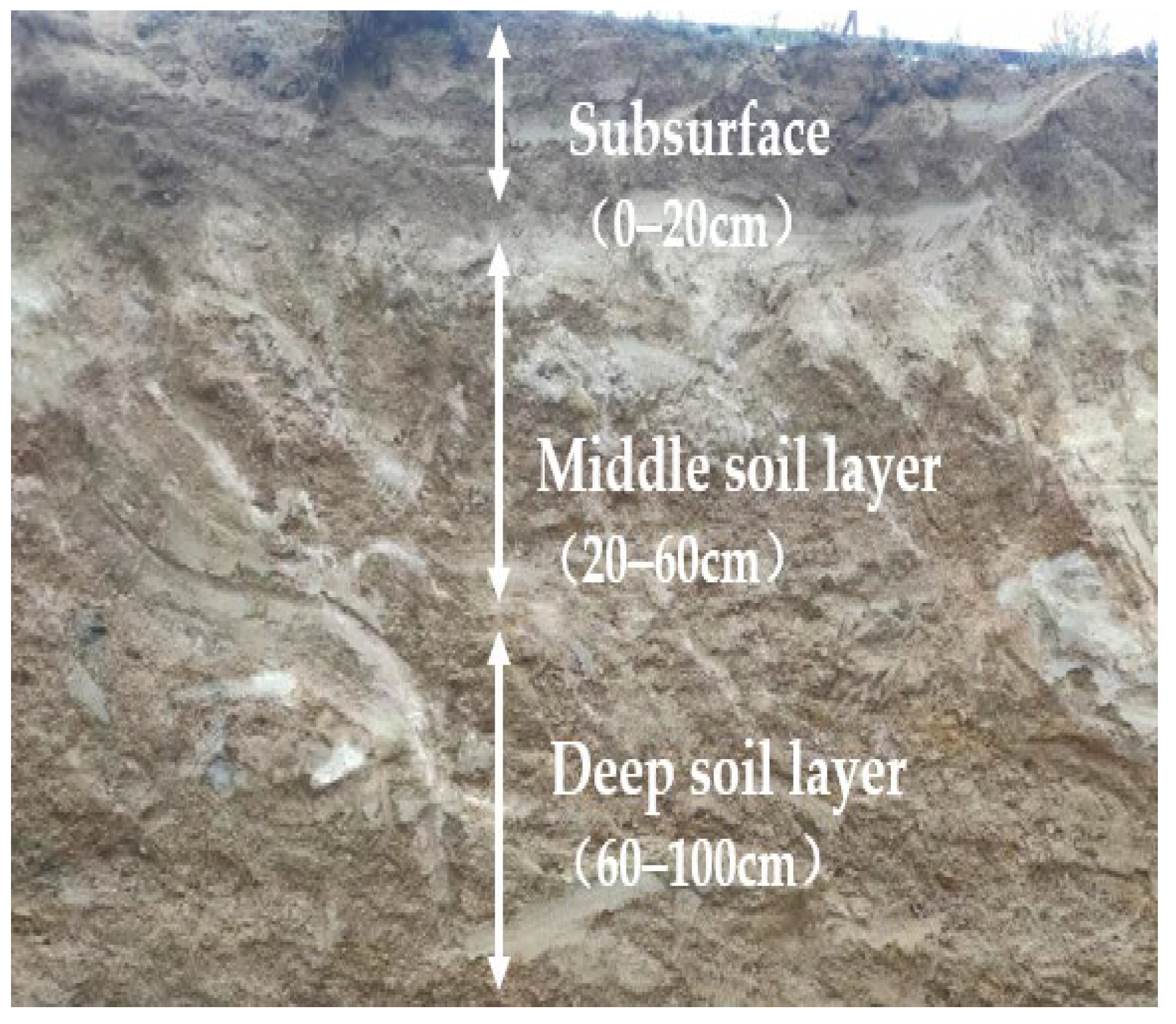
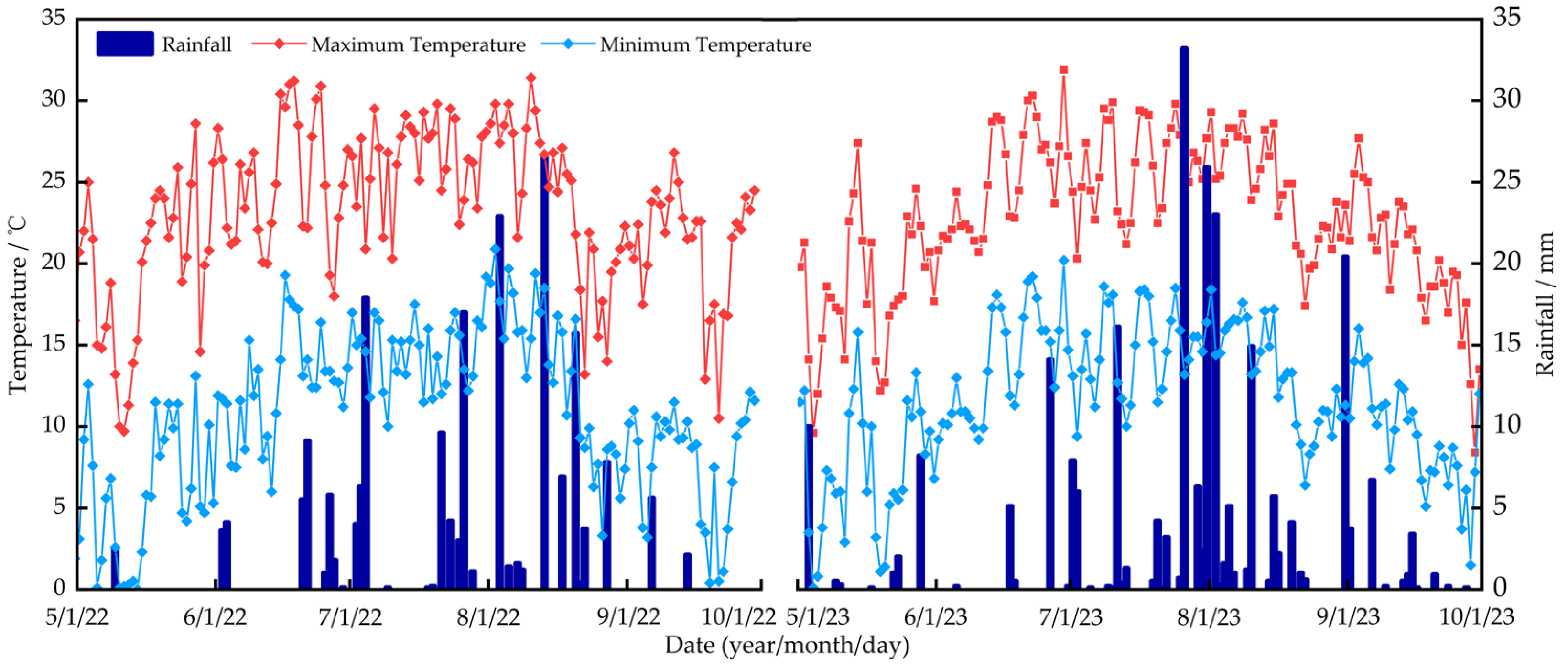


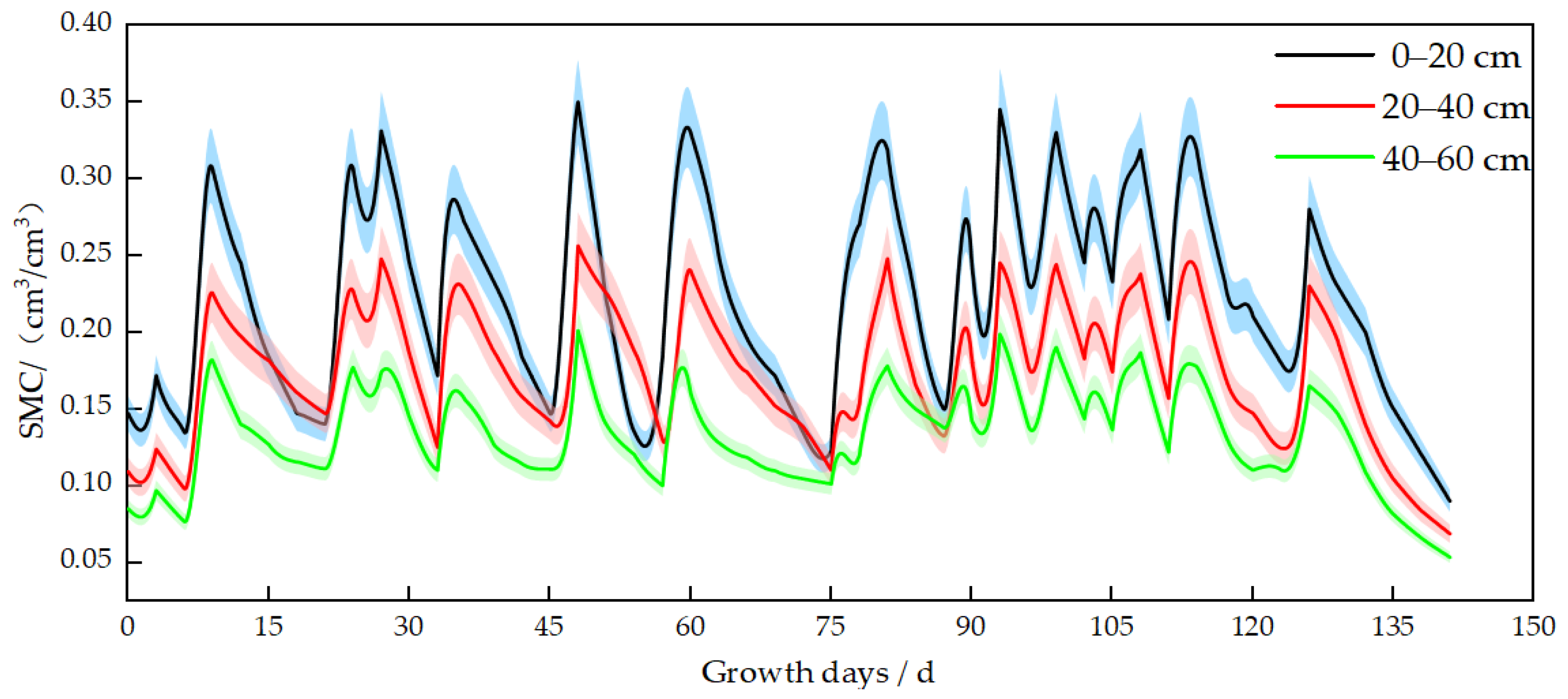
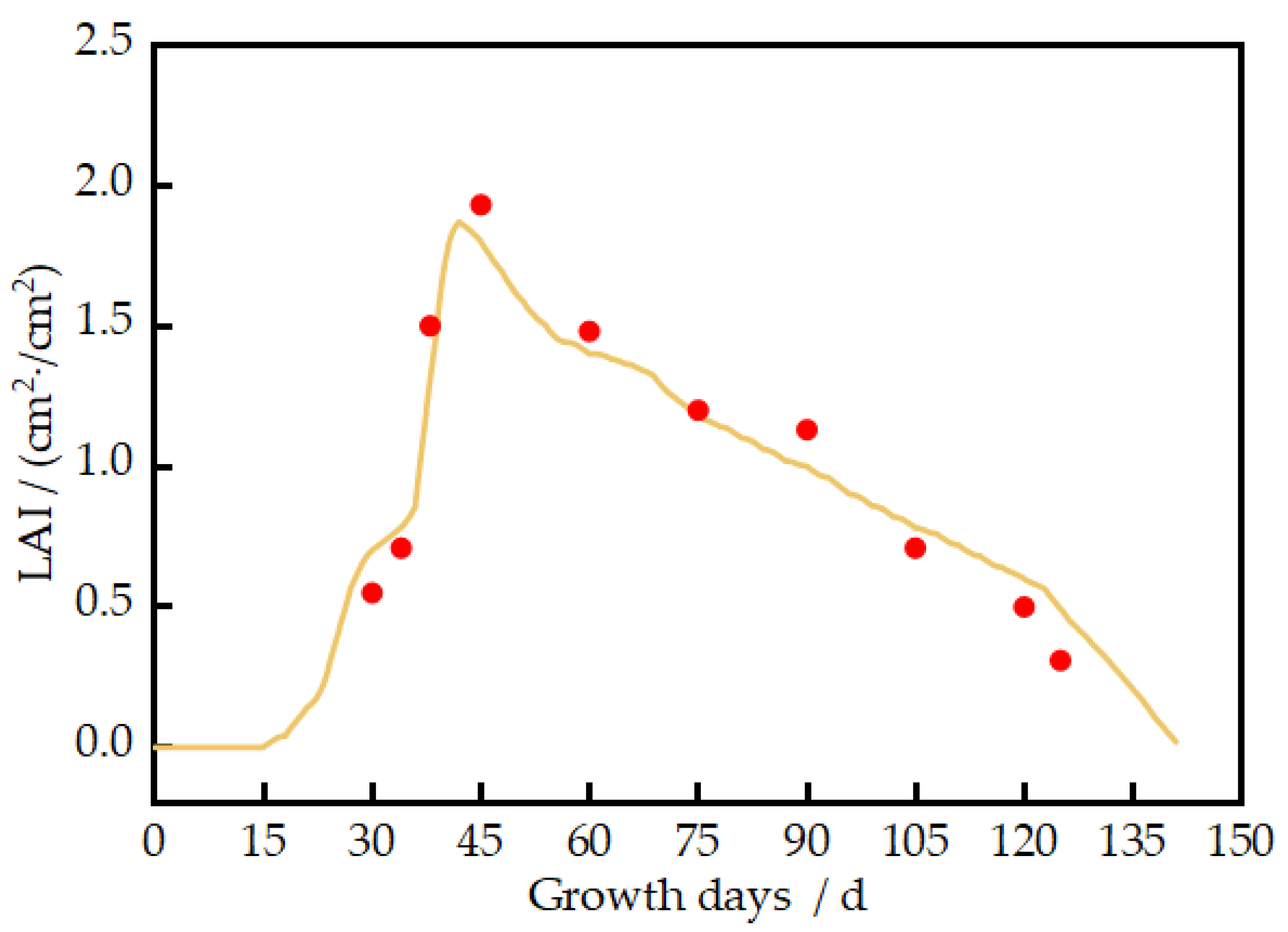
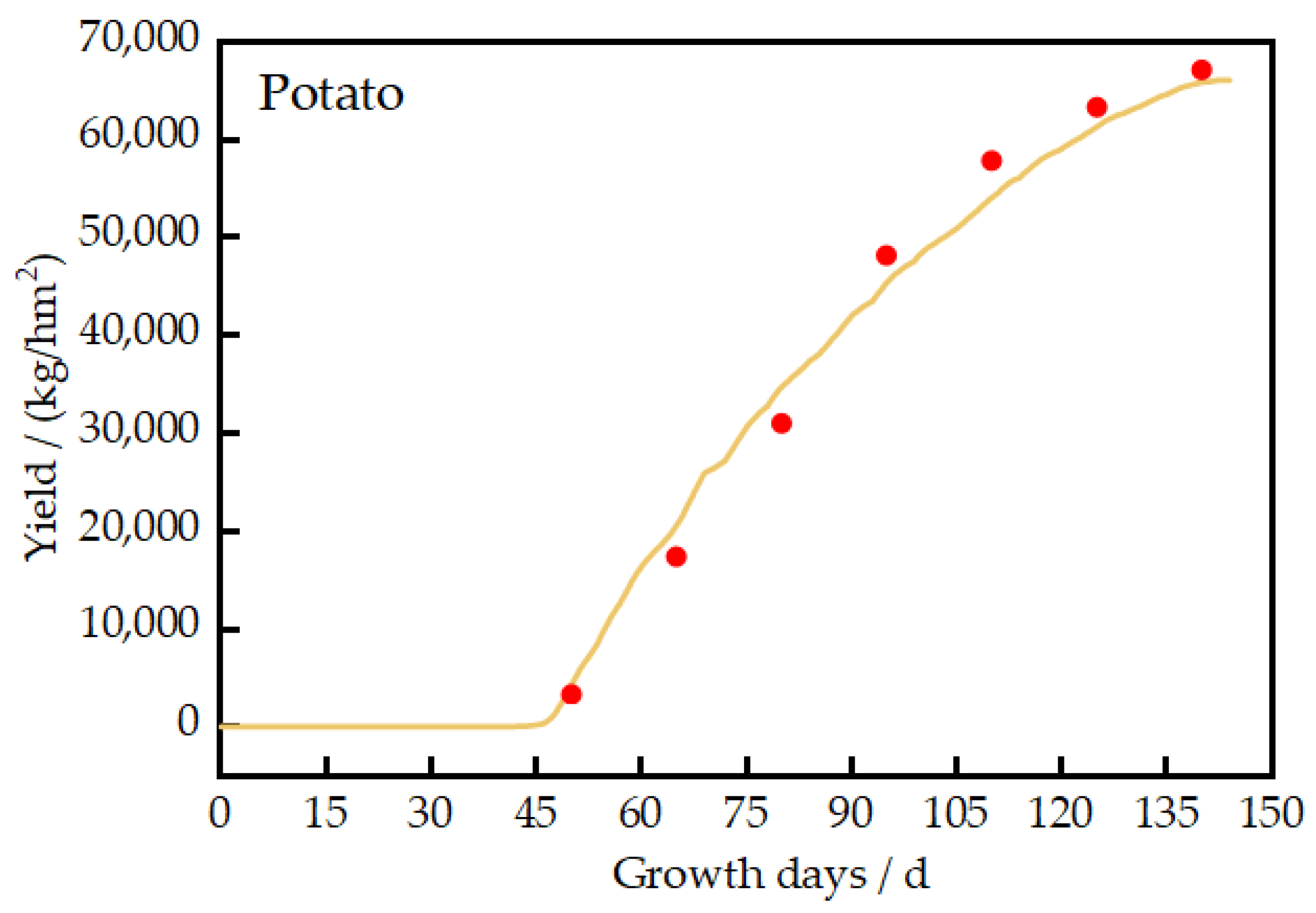

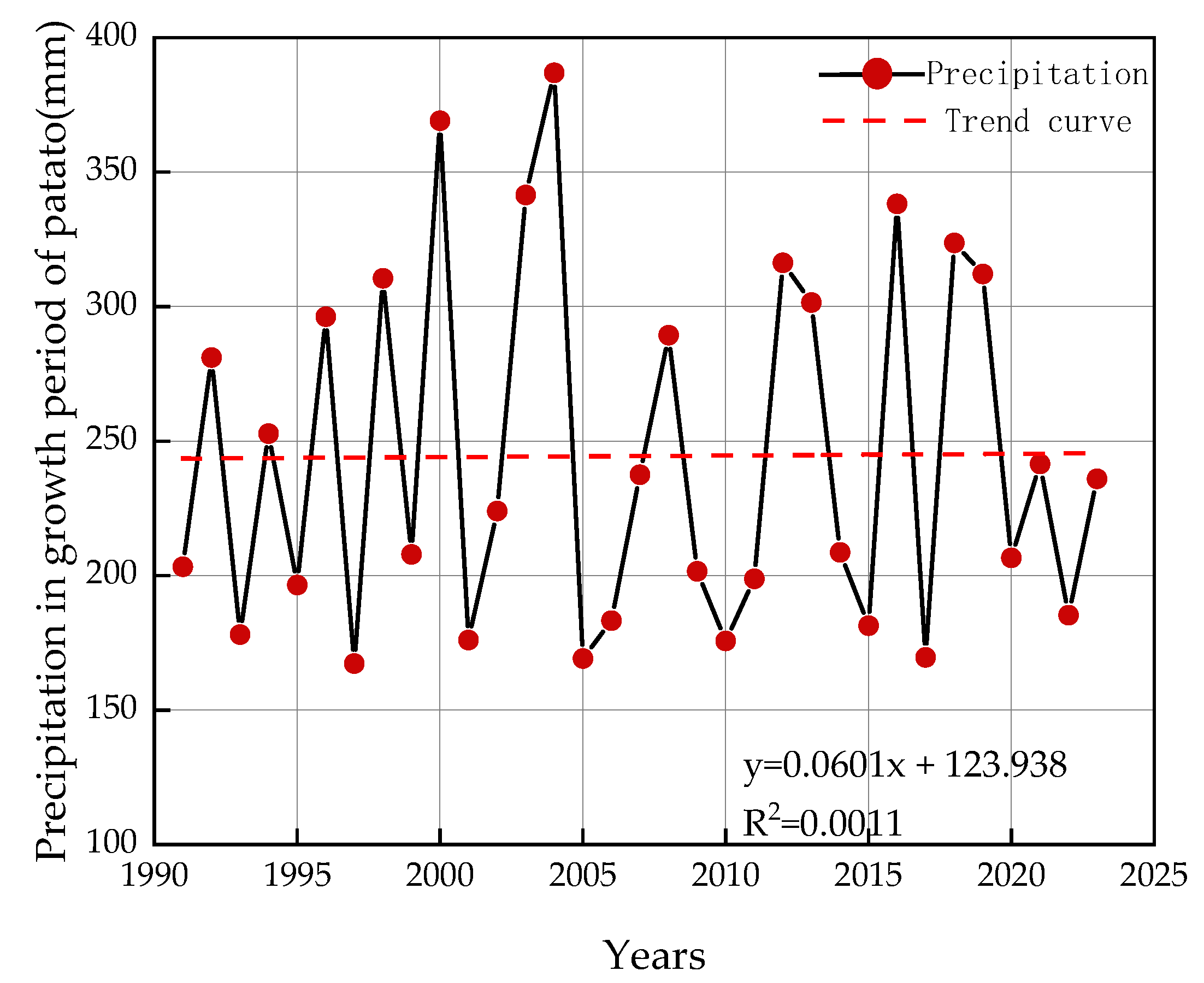
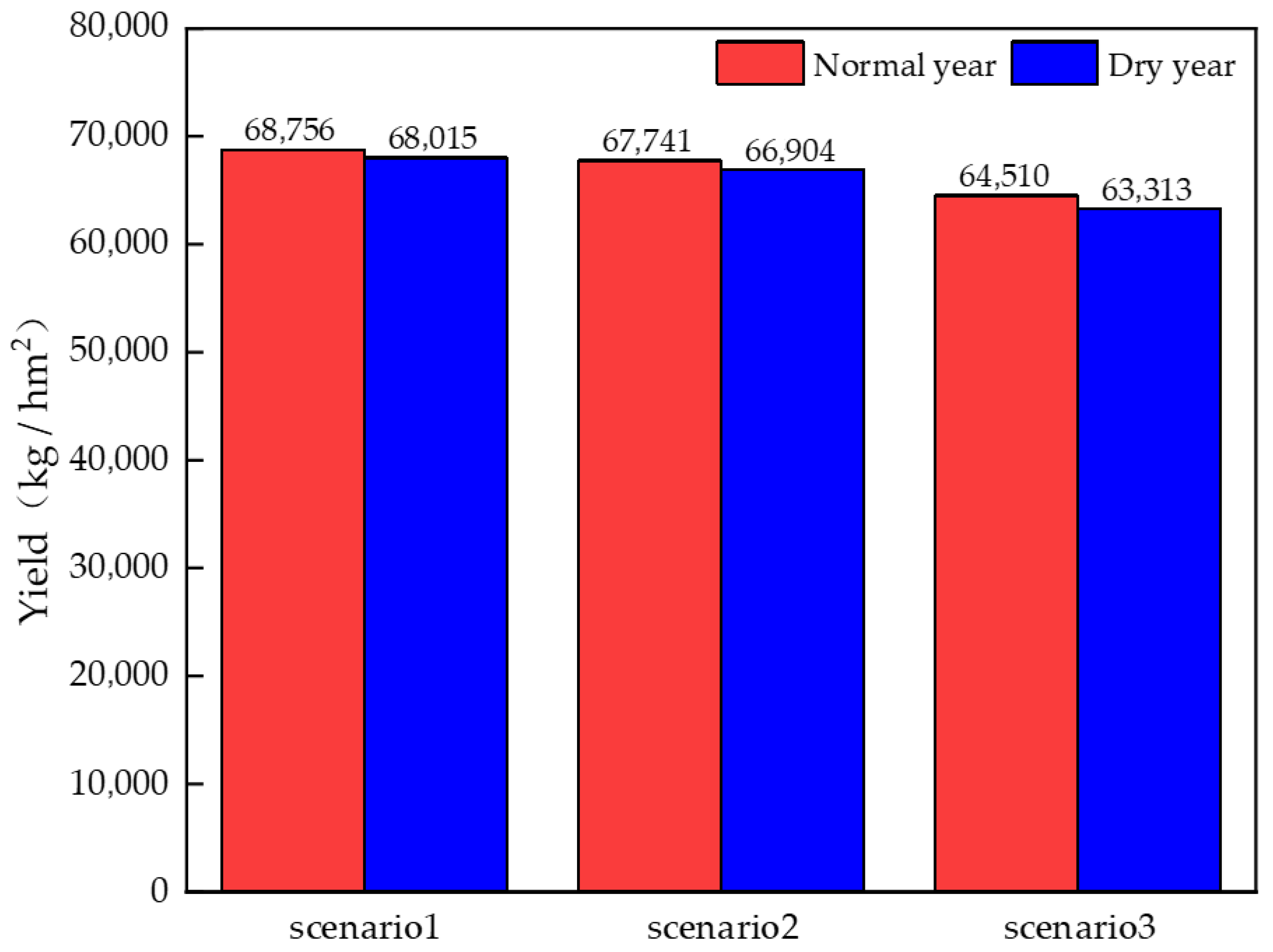
| Soil Layer Depth | Bulk Density | Field Moisture Capacity | Saturated Soil Water Content | Available p | Available K | Soil Organic Matter | pH | |||||||
|---|---|---|---|---|---|---|---|---|---|---|---|---|---|---|
| (cm) | (g/cm3) | (cm3/cm3) | (cm3/cm3) | (g/kg) | (g/kg) | (g/kg) | ||||||||
| 2022 | 2023 | 2022 | 2023 | 2022 | 2023 | 2022 | 2023 | 2022 | 2023 | 2022 | 2023 | 2022 | 2023 | |
| 0–20 | 1.34 | 1.36 | 0.32 | 0.30 | 0.35 | 0.35 | 0.01159 | 0.01208 | 0.16388 | 0.15872 | 2.17 | 2.31 | 7.29 | 7.16 |
| 20–40 | 1.57 | 1.51 | 0.25 | 0.24 | 0.29 | 0.26 | 0.00456 | 0.00534 | 0.13275 | 0.12831 | 5.61 | 5.74 | 7.11 | 6.97 |
| 40–60 | 1.58 | 1.57 | 0.23 | 0.18 | 0.23 | 0.20 | 0.00309 | 0.00298 | 0.07456 | 0.07178 | 1.49 | 1.73 | 7.08 | 7.03 |
| 60–80 | 1.62 | 1.61 | 0.17 | 0.21 | 0.21 | 0.21 | 0.00184 | 0.00185 | 0.06637 | 0.06723 | 0.69 | 0.72 | 6.96 | 6.92 |
| 80–100 | 1.65 | 1.63 | 0.13 | 0.14 | 0.17 | 0.16 | 0.00157 | 0.00169 | 0.09232 | 0.08875 | 0.52 | 0.48 | 6.93 | 6.82 |
| Growth Period | 2022 | 2023 | ||
|---|---|---|---|---|
| Period | Growth Days | Period | Growth Days | |
| Sowing–Emergence | 2/5~27/5 | 25 d | 1/5~28/5 | 27 d |
| Emergence–Formation | 28/5~26/6 | 30 d | 29/5~29/6 | 32 d |
| Formation–Bulking | 27/6~15/8 | 50 d | 30/6~19/8 | 51 d |
| Bulking–Harvest | 16/8~11/9 | 28 d | 20/8~13/9 | 24 d |
| Total | 2/5~11/9 | 133 d | 1/5~13/9 | 134 d |
| Growth Stage | Irrigation Amount (mm) | |
|---|---|---|
| 2022 | 2023 | |
| Sowing–Emergence | 32 | 31 |
| Emergence–Formation | 55 | 50 |
| Formation–Bulking | 66 | 57 |
| Bulking–Harvest | 20 | 18 |
| Total | 173 | 156 |
| Parameters | P2 | G3 | SOL-AWC | SOL-NH4 | SRAD | NAPP | IRRIG | SW0–30 cm | |
|---|---|---|---|---|---|---|---|---|---|
| SMC | β | 0.03 | 0.14 | 0.28 | 0.09 | 0.06 | 0.04 | 0.45 | 0.02 |
| contribute | 2.60% | 12.30% | 24.60% | 7.90% | 5.30% | 3.50% | 39.50% | 2.30% | |
| LAI | β | 0.08 | 0.27 | 0.18 | 0.12 | 0.39 | 0.05 | 0.03 | 0.02 |
| contribute | 7.10% | 24.10% | 16.10% | 10.70% | 34.80% | 4.50% | 2.70% | 2.00% | |
| Yield | β | 0.37 | 0.37 | 0.21 | 0.13 | 0.07 | 0.29 | 0.21 | 0.01 |
| contribute | 32.60% | 32.60% | 18.50% | 11.50% | 6.20% | 25.50% | 18.50% | 1.50% | |
| d-Factor | Parameters | |||||||
|---|---|---|---|---|---|---|---|---|
| P2 | G3 | SOL-AWC | SOL-NH4 | SRAD | NAPP | IRRIG | SW0–30 cm | |
| SMC | 0.02 | 0.01 | 0.22 | 0.07 | 0.05 | 0.03 | 0.36 | 0.11 |
| LAI | 0.04 | 0.23 | 0.07 | 0.03 | 0.31 | 0.15 | 0.10 | 0.02 |
| Yield | 0.03 | 0.30 | 0.11 | 0.02 | 0.06 | 0.23 | 0.17 | 0.01 |
| Index | LAI/(cm2/cm−2) | Yield/(kg/hm2) |
|---|---|---|
| ARE/% | 4.18 | 4.89 |
| nRMSE/% | 5.64 | 6.57 |
| R2 | 0.88 | 0.87 |
| Soil Layer/cm | ARE/% | nRMSE/% | R2 |
|---|---|---|---|
| 0–20 | 5.27 | 7.87 | 0.87 |
| 20–40 | 6.34 | 8.65 | 0.86 |
| 40–60 | 4.88 | 6.82 | 0.88 |
| Parameters | Definition | Calibrated Value |
|---|---|---|
| G2 | Leaf area expansion rate [cm2/(m2·d)] | 1100 |
| G3 | Potential tuber growth rate [g/(plant·d)] | 23.3 |
| PD | Tuber growth stress coefficient | 0.9 |
| P2 | Photo period coefficient | 0.5 |
| TC | Upper limit critical temperature for tubers to start growing | 20 |
| Variety | Growth Stage | Water Consumption (mm) | Water Consumption Modulus | Water Consumption Intensity (mm/d) | |||
| 2022 | 2023 | 2022 | 2023 | 2022 | 2023 | ||
| Potato | Sowing–Emergence | 43.80 | 42.17 | 15% | 13% | 2.25 | 1.99 |
| Emergence–Formation | 73.00 | 77.86 | 25% | 24% | 3.13 | 3.11 | |
| Formation–Bulking | 146.00 | 168.69 | 50% | 52% | 3.75 | 4.22 | |
| Bulking–Harvest | 29.20 | 35.68 | 10% | 11% | 1.34 | 1.90 | |
| Total/Average | 375.2 | 414.2 | 1.00 | 1.00 | 2.62 | 2.81 | |
| Parameters | Rain/mm | Irrigation/mm | ΔW (Soil Water Storage Change)/mm | Evapotranspiration/mm | Evaporation/mm | Transpiration/mm | Percolation/mm | |||||||
|---|---|---|---|---|---|---|---|---|---|---|---|---|---|---|
| Year | 2022 | 2023 | 2022 | 2023 | 2022 | 2023 | 2022 | 2023 | 2022 | 2023 | 2022 | 2023 | 2022 | 2023 |
| potato | 185.3 | 236 | 173 | 156 | −41.6 | −44.9 | 375.2 | 414.2 | 255.14 | 236.1 | 120.06 | 178.1 | 24.7 | 22.7 |
| Parameters | Irrigation/mm | Evapotranspiration/mm | Yield /(kg/hm2) | Rainfed Yield/(kg/hm2) | Water Use Efficiency/ (kg/hm2·mm) | Irrigation Water Use Efficiency/ (kg/hm2·mm) | ||||||
|---|---|---|---|---|---|---|---|---|---|---|---|---|
| Year | 2022 | 2023 | 2022 | 2023 | 2022 | 2023 | 2022 | 2023 | 2022 | 2023 | 2022 | 2023 |
| potato | 173 | 156 | 375.2 | 414.2 | 62,355 | 67,170 | 43,649 | 53,736 | 166.20 | 162.17 | 108.1 | 86.1 |
| Hydrological Year | Different Irrigation Schemes | Irrigation Water (mm) | Hydrological Year | Different Irrigation Schemes | Irrigation Water (mm) |
|---|---|---|---|---|---|
| Normal year | 1 | 180 | Dry year | 1 | 240 |
| 2 | 162 | 2 | 216 | ||
| 3 | 144 | 3 | 192 |
| Hydrological Year | Different Irrigation Schemes | Irrigation/mm | Evapotranspiration/mm | Yield/ (kg/hm2) | Water Use Efficiency/ (kg/hm2·mm) |
|---|---|---|---|---|---|
| Normal year | 1 | 180 | 427 | 68,756 | 160.3 |
| 2 | 162 | 409 | 67,741 | 164.8 | |
| 3 | 144 | 391 | 64,510 | 164.1 |
| Hydrological Year | Different Irrigation Schemes | Irrigation/mm | Evapotranspiration/mm | Yield/ (kg/hm2) | Water Use Efficiency/ (kg/hm2·mm) |
|---|---|---|---|---|---|
| Dry year | 1 | 240 | 410 | 68,015 | 164.7 |
| 2 | 216 | 385 | 66,904 | 172.0 | |
| 3 | 192 | 360 | 63,313 | 173.5 |
Disclaimer/Publisher’s Note: The statements, opinions and data contained in all publications are solely those of the individual author(s) and contributor(s) and not of MDPI and/or the editor(s). MDPI and/or the editor(s) disclaim responsibility for any injury to people or property resulting from any ideas, methods, instructions or products referred to in the content. |
© 2025 by the authors. Licensee MDPI, Basel, Switzerland. This article is an open access article distributed under the terms and conditions of the Creative Commons Attribution (CC BY) license (https://creativecommons.org/licenses/by/4.0/).
Share and Cite
Wang, G.; Miao, X.; Wang, J.; Tian, D.; Ren, J.; Li, Z. Analysis of Potato Growth, Water Consumption Characteristics and Irrigation Strategies in the Agro-Pastoral Ecotone of Northwest China. Agronomy 2025, 15, 2685. https://doi.org/10.3390/agronomy15122685
Wang G, Miao X, Wang J, Tian D, Ren J, Li Z. Analysis of Potato Growth, Water Consumption Characteristics and Irrigation Strategies in the Agro-Pastoral Ecotone of Northwest China. Agronomy. 2025; 15(12):2685. https://doi.org/10.3390/agronomy15122685
Chicago/Turabian StyleWang, Guoshuai, Xiangyang Miao, Jun Wang, Delong Tian, Jie Ren, and Zekun Li. 2025. "Analysis of Potato Growth, Water Consumption Characteristics and Irrigation Strategies in the Agro-Pastoral Ecotone of Northwest China" Agronomy 15, no. 12: 2685. https://doi.org/10.3390/agronomy15122685
APA StyleWang, G., Miao, X., Wang, J., Tian, D., Ren, J., & Li, Z. (2025). Analysis of Potato Growth, Water Consumption Characteristics and Irrigation Strategies in the Agro-Pastoral Ecotone of Northwest China. Agronomy, 15(12), 2685. https://doi.org/10.3390/agronomy15122685





